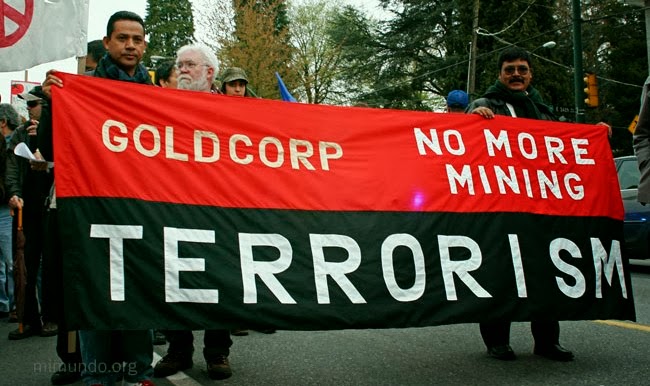 |
| Protests in Canada – image source |
Derrick Broze
Activist Post
Canadian company Goldcorp Incorporated has a history of controversial mining operations in both Guatemala and Honduras. Although many would believe that the atrocities committed to native or indigenous peoples are a thing of the past; companies like Goldcorp provide evidence to the contrary.
Canada is home to the largest number of mining companies in the world with projects in more than 120 countries around the globe. The Canadian government allows mining companies to adopt voluntary policies, a move that some say is to blame for the violations of law committed by companies like Goldcorp.
Goldcorp is a gold mining company based out of Vancouver, British Columbia, Canada. Their main operations involve extraction, exploration, reclamation, and processing precious metals. The company currently has five mines in Canada and the U.S., three mines in Mexico, and two in Central and South America.
Despite, or perhaps because of, Goldcorp’s experience as an international mining company there have been a number of blights on their record. Ranging from water contamination to murder, the Crimes of Goldcorp must not go unnoticed.
Honduras and the San Martin Mine
A Goldcorp subsidiary has been operating gold and silver mines in Honduras since 2000. Entre Mares’ San Martin mine in the Siria Valley of Honduras has been surrounded by controversy since at least 2004 when independent studies showed the mine to be a source of contamination for the environment and the bodies of local residents.
Goldcorp was first fined in 2007 by the Honduran Secretariat of Natural Resources and Environment (SERNA) for pollution and environmental damage. Also in 2007 the Latin America Water Tribunal found the company guilty of damaging the water and environment in the Siria Valley. The tribunal is an autonomous, independent environmental justice organization, They found Entre Mares to be “guilty and must take responsibility for inappropriate use and contamination of water sources in the [Siria Valley] region and for causing harm and risk to the ecosystem and to human health.” (Source)
In 2010 the Catholic Aid For Overseas Development (CAFOD) uncovered a previously unreleased water monitoring report detailing dangers to the water and environment surrounding the mining operations. The report was carried out in 2009 by experts from Newcastle University at the request of the Honduran government. The report showed visual evidence of damage from acid drainage located close to the mine site. Paul Younger, a Newcastle university hydro-geochemical engineering professor, stated that when the sulphuric acid is released into the air it can have devastating effects on animals and plants. (Source)
In 2011 Dr. Juan Almendarez wrote about his participation in a forensic report commissioned by the Honduran government. The report analyzed blood and urine samples from 61 people of the community of El Pedernal, and one person from the community of Nueva Palo Ralo, in the Siria Valley. The report was commissioned in 2007 but, once again, was not released until 4 years later. (Source)
 The report found serious lead poisoning from the people of Pedernal. Dr. Almendarez, former Dean of the Faculty of Medical Sciences and former Vice-President of the National Autonomous University of Honduras, also stated:
The report found serious lead poisoning from the people of Pedernal. Dr. Almendarez, former Dean of the Faculty of Medical Sciences and former Vice-President of the National Autonomous University of Honduras, also stated:
The Government’s failure to carry out blood sample analysis of mercury, arsenic and other metals and semi-metals is incomprehensible and appears to be intentional negligence – it is urgent that these studies be carried out.
The Government of Honduras and Goldcorp are socially, judicially and ethically responsible for concealing information for almost four years from people who were subjects of laboratory examinations. (Source)
Guatemala and the Marlin Mine
The Marlin mine located in San Miguel and Sipacapa, Guatemala first went into production under Glamis gold in 2005. A year later Glamis was purchased by Goldcorp. It didn’t take for Goldcorp’s familiar policies to show up.
The documentary Sipacapa Is Not For Sale documents the Mayan Sipacapan peoples rejecting of Goldcorp’s mine in their territory. The Sipacapa signed a legally binding community consultation declaring their opposition. Since 2008 human rights reports have declared that the mine was acquired with the “free, prior and informed consent” of affected communities. In 2010 a study by Physicians for Human Rights found that “some residents living near the mine have relatively high levels of lead in their blood and arsenic in their urine.”
Beyond the dangers to the environment there have been a number of violations of human rights. Amnesty International reported that activists protesting the Marlin mine were attacked in 2010 and 2011. There have also been confirmed reports of attempted assassinations of those who speak out against Goldcorp attempting to seize their land. As recently as last month troops were ordered into Sipakapa by Guatemalan President Otto Perez Molina. The troops were sent on behalf of Goldcorp as the communities begin to rise up.
On January 14th thousands of farmers from Sipacapa, San Miguel and 5 other municipalities came to the village of Pie de la Cuesta, Sipacapa to resist the Goldcorp mining operations. During the gathering a representative from Goldcorp signed a public agreement with Sipacapan community members agreeing to suspend work and withdraw from the “Los Chocoyos” site in the village. The community gave Goldcorp two days to remove their equipment from the area.
The Impact on Local Health
In July 2012 the first ever People’s Health Tribunal was held in San Miguel, Guatemala. The Tribunal’s twelve judges included human rights defenders and ecologists, health specialists, and scientists from five different countries. The judges heard from residents affected by the Marlin mine, Goldcorp’s Los Filos mine in Mexico, and the San Martin mine in Honduras.
The PHT hoped to look at the holistic health impacts of open-pit mining in the area. They looked at the environmental health, physical health as well as emotional psychological health of the communities. The judges found some common health related issues in all three Goldcorp mines including respiratory disease, skin disease, rise in cancer, premature births, birth defects and assassinations.
REBUILD AND RESIST
These horrible crimes against humanity and the environment have not gone completely unchallenged. As recently as January 8th a lawsuit was filed against the mayor of San Miguel on behalf of five communities which have dealt with water shortage and contamination since Goldcorp began mining in 2005.
 While some challenge Goldcorp and the Guatemalan and Honduran governments in the courtroom, others seek to vote them out through binding community consultations. Since 2005 the majority of all consultas held voted “No” to development of community lands. The Guatemalan government is now seeking to ignore these agreements, stating that they are not legally binding.
While some challenge Goldcorp and the Guatemalan and Honduran governments in the courtroom, others seek to vote them out through binding community consultations. Since 2005 the majority of all consultas held voted “No” to development of community lands. The Guatemalan government is now seeking to ignore these agreements, stating that they are not legally binding.
When communities tire of the political and legal routes they often take to the streets to assemble and resist the efforts of multinational companies. They are often met with force and violence. A confrontation at the Marlin mine in 2004 brought 1,200 soldiers, 400 police officers, tear gas, bullets, and one dead protester. (Source)
Despite the number of studies released and suppressed, the reported violence and damage to the environment, Goldcorp seems unscathed and unremorseful. In May 2011 Goldcorp CEO Chuck Jeannes responded to the allegations by stating, “The No. 1 and most important factor is that we are operating the mine to international standards from the very beginning.”
While it may be easier for a CEO of a billion dollar business to remain ignorant of the damage caused by his company’s actions, the people of San Miguel and Sipacapa, Guatemala, and the Siria Valley of Honduras have a more difficult time ignoring the destruction of their homelands and the poisoning of their people. Goldcorp, and the industry they represent, seem to be indicative of disregard for those affected by their policies and operations.
We have to ask ourselves whether the energy sources, and devices we use are worth the complete excavation of the planet and the cultures that helped shape its history. Are there are other more sustainable methods we could make use of that don’t require gold? Could better communication lend itself to an agreement among the people living in resource-rich areas and the companies hoping to make use of the land?
Only with respect for this planet and the life on it will we create solutions that can allow all life to advance forward without the loss of cultural identity or environments. Please continue to do your work exposing corrupt corporations such as Goldcorp and stand in solidarity with all those resisting them with their very lives.
Sources / more information:
- The history of Goldcorp’s “Marlin” mining operation, the harms and violations caused, and the resistance of the Mayan Mam people, is documented in Gold Fever (www.goldfevermovie.com).
- http://intercontinentalcry.org/goldcorp-guatemala-water-deprivation-militarized-expansion/
- http://vimeo.com/11867068
- http://www.youtube.com/watch?v=Kl6pyTXW8-Q
- http://www.indypendent.org/2012/09/10/goldcorp-trial
Recently by Derrick Broze:
- ACLU Seeks Information on FBI’s Secretive “Port Readers”
- The War on Journalism: Local to Federal
- Ben Swann on Spirituality, 9/11, Censorship, GeoEngineering
Derrick Broze is an investigative journalist, community activist, gardener and promoter from Houston, Texas. He is the co-founder of The Houston Free Thinkers, and co-host of Free Thinker Radio. Broze also hosts and produces a weekly podcast under the name the Conscious Resistance Live. His writing can be found on TheConsciousResistance.com, The Liberty Beat, the Anti-Media, Intellihub, Activist Post, and other independent media sources.


Be the first to comment on "The Crimes of Goldcorp: Assaults on Indigenous in Honduras and Guatemala"